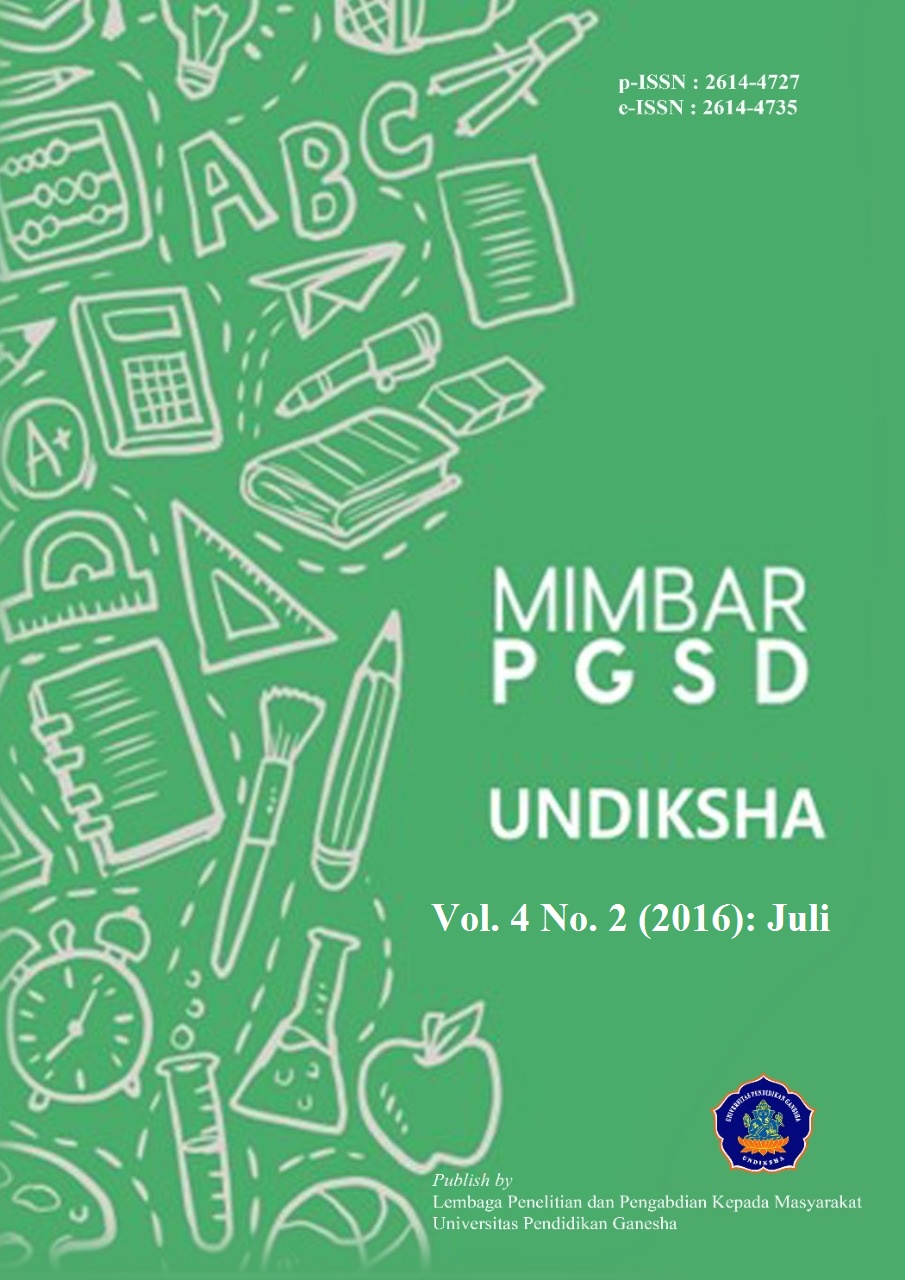PENERAPAN MODEL PEMBELAJARAN PENEMUAN TERBIMBING UNTUK MENINGKATKAN KETERAMPILAN PROSES DAN PRESTASI BELAJAR IPA KELAS V
DOI:
https://doi.org/10.23887/jjpgsd.v4i2.7567Abstract
Penelitian ini bertujuan untuk mengetahui peningkatan (1) keterampilan proses dan (2) prestasi belajar IPA siswa kelas V di SD N 3 Banjar Tegal melalui penerapan model pembelajaran Penemuan Terbimbing. Penelitian ini merupakan Penelitian Tindakan Kelas, dengan subjek penelitian yaitu siswa kelas V di SD N 3 Banjar Tegal yang berjumlah 7 orang. Penelitian ini dilaksanakan dalam 2 siklus, yang terdiri atas 4 kali pertemuan. Pengumpulan data dalam penelitian ini dilakukan menggunakan metode observasi dan tes, dengan instrumen berupa lembar observasi keterampilan proses dan tes prestasi belajar. Analisis data yang digunakan yaitu analisis deskriptif kuantitatif. Berdasarkan hasil penelitian, pada siklus I, tingkat skor rata-rata keterampilan proses siswa adalah 7,05 dengan kategori “sedang” dan tingkat persentase rata-rata prestasi belajar siswa adalah 63,81% pada kriteria sedang. Berdasarkan hasil ini, menunjukkan bahwa indikator keberhasilan yang ditetapkan belum terpenuhi. Pada siklus II, skor rata-rata keterampilan proses siswa adalah 9,57 dengan kategori “tinggi” dan persentase rata-rata prestasi belajar siswa adalah 78,1% pada kriteria ”tinggi”. Hal ini berarti, indikator keberhasilan yang ditetapkan sudah terpenuhi pada siklus II. Berdasarkan hasil penelitian, dapat disimpulkan bahwa penerapan model pembelajaran Penemuan Terbimbing dapat meningkatkan (1) keterampilan proses dan (2) prestasi belajar IPA siswa kelas V SD Negeri 3 Banjar Tegal.Kata Kunci : keterampilan proses, penemuan terbimbing, prestasi belajar
This study aims to increase (1) processing skills and (2) learning achievement of science in fifth grade at SD N 3 Banjar Tegal through applicating the guided discovery learning model. This research is a classroom action research, with the subjects are students of grade V in SD N 3 Banjar Tegal that has 7 student. This study was conducted in two cycles, consisting of 4 meetings. The data in this case collected by using the method of observation and tests, with the form of sheets of observation skills instrument and tests of learning achievement. the data Analysed by quantitative descriptive analysis. Based on the research results, in the first cycle, the average score of students' processing skills is 7,05 with the category of "moderate" and the percentage average of student achievement is 63.81% on the category of "moderate" too. Based on these results, showed that the indicators of success in case have not been get. In the second cycle, the average score was 9.57 processing skills of students with the category of "high" and the average percentage of student achievement is 78.1% on the criteria of "high". This means that the indicators of success set are get in the second cycle. Based on the results, it can be concluded that the application of Guided discovery learning model can improve (1) processing skills and (2) the learning achievement of science grade V students at SD Negeri 3 Banjar Tegal
keyword : guided discovery learning, learning achievement, processing skills
Published
2016-07-17
How to Cite
., M. P. K., ., D. D. N. S., & ., D. G. N. J. (2016). PENERAPAN MODEL PEMBELAJARAN PENEMUAN TERBIMBING UNTUK MENINGKATKAN KETERAMPILAN PROSES DAN PRESTASI BELAJAR IPA KELAS V. MIMBAR PGSD Undiksha, 4(2). https://doi.org/10.23887/jjpgsd.v4i2.7567
Issue
Section
Articles
License
Authors who publish with the Mimbar PGSD Undiksha agree to the following terms:
- Authors retain copyright and grant the journal the right of first publication with the work simultaneously licensed under a Creative Commons Attribution License (CC BY-SA 4.0) that allows others to share the work with an acknowledgment of the work's authorship and initial publication in this journal.
- Authors are able to enter into separate, additional contractual arrangements for the non-exclusive distribution of the journal's published version of the work (e.g., post it to an institutional repository or publish it in a book), with an acknowledgment of its initial publication in this journal.
- Authors are permitted and encouraged to post their work online (e.g., in institutional repositories or on their website) prior to and during the submission process, as it can lead to productive exchanges, as well as earlier and greater citation of published work. (See The Effect of Open Access)















